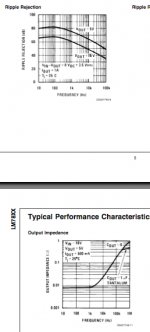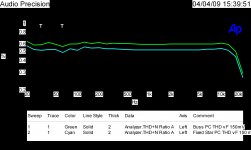The ripple from the raw PSU is about 500 mV. The ripple rejection in LM7815 is typical 70 dB @ 120 Hz and 1A. Add to that 100 dB in the opamp. I think it's enough..
Two points of uncertainty:
1. What is the ripple rejection in LM7815 @ 30 mA load?
2. What about higher frequencies?
To force the opamps into class A is intriguing but somewhat outside this minimalistic approach. I would have used a constant current source for that purpose. A FET and a resistor, maybe.
Two points of uncertainty:
1. What is the ripple rejection in LM7815 @ 30 mA load?
2. What about higher frequencies?
To force the opamps into class A is intriguing but somewhat outside this minimalistic approach. I would have used a constant current source for that purpose. A FET and a resistor, maybe.
Yes, a Fet with a sorce resistor is better. I whould then add a 1kOhm resistor in series to avoid capacitive loading. But again, 3 more parts.
Well drawn, Joachim. This is essentially your 'well engineered' people's preamp.
I suspect that it will beat 75% of the commercial stuff out there. Why? Because it is simple, clean, and uses NO CERAMICS in the audio path. Just one ceramic could modify it enough to be slightly annoying to listen to.
This little design should meet any double blind criteria for excellence with a moving magnet cartridge, and be a virtually 'perfect' line amp. Dr. Lipshitz, please take note. SY, I recommend that you junk your tube stuff and make this little number. Save heat, energy, and space. A real wife pleaser. ;-)
To show appreciation for audio engineering discoveries over the last 45 years, I recommend that we use a relatively high speed rectifier diode, to prevent generating RFI, from a slower turn-off diode. Perhaps, a high speed version of the 1N4004 would work OK.
I suspect that it will beat 75% of the commercial stuff out there. Why? Because it is simple, clean, and uses NO CERAMICS in the audio path. Just one ceramic could modify it enough to be slightly annoying to listen to.
This little design should meet any double blind criteria for excellence with a moving magnet cartridge, and be a virtually 'perfect' line amp. Dr. Lipshitz, please take note. SY, I recommend that you junk your tube stuff and make this little number. Save heat, energy, and space. A real wife pleaser. ;-)
To show appreciation for audio engineering discoveries over the last 45 years, I recommend that we use a relatively high speed rectifier diode, to prevent generating RFI, from a slower turn-off diode. Perhaps, a high speed version of the 1N4004 would work OK.
Instead of going forward and doing an amateurish layout, I recommend that we drop this project and move on to something more effective in making music.
In this case, I recommend a 2 stage phono desgin, as was already (prematurely) brought up by PMA, Dimitri, and others. This can be made of op amps, too, just a different topology. Why should this sound different, or even possibly better? Heck if I know!
In this case, I recommend a 2 stage phono desgin, as was already (prematurely) brought up by PMA, Dimitri, and others. This can be made of op amps, too, just a different topology. Why should this sound different, or even possibly better? Heck if I know!
Yes, a Fet with a sorce resistor is better. I whould then add a 1kOhm resistor in series to avoid capacitive loading. But again, 3 more parts.
It is REALLY difficult to hold back on components 🙂🙂
I look forward to "the extended versions". There is room for an infinite number of variations to this simple circuit.
But now we need to add what I like to think of as the most important single component: The PCB. Several years in pro audio design is my reason for this argument. I have no experience with the OPAx134 series. But using components like 5532s and 5534s from different vendors in several designs has been an important lesson to me. PCB layout is critical!
Instead of going forward and doing an amateurish layout, I recommend that we drop this project and move on to something more effective in making music.
In this case, I recommend a 2 stage phono desgin, as was already (prematurely) brought up by PMA, Dimitri, and others. This can be made of op amps, too, just a different topology. Why should this sound different, or even possibly better? Heck if I know!
Seems that we had a little cross-posting here 🙂
Oh heck, it is 9 time zones between us 🙂
A 2 stage phono stage splits the allmost impossible task of using only one opamp into something easier to handle. Several approaches are possible, including passive RIAA. The best part is perhaps not using 60 dB of gain in a single opamp.
Cross posting is typical, because I am under permanent moderation, and must wait up to several hours to have my message posted. Sorry about that, but they don't want me to say something that might annoy another DIY member, and I can't seem to avoid it, on occasion. ;-)
SY, I recommend that you junk your tube stuff and make this little number. Save heat, energy, and space. A real wife pleaser. ;-)
John, I recommend you dump that $20k unit and build one of mine. Performs well, glows, and will waste yours for overload margin. You can use the remaining $19,500 to throw one hell of a party.
Could it be a good compromise to make the input stage discrete and the second stage with Opamp ? That way we could integrate the 75usec in the input stage. I whould go for a transconductance, transimpedance, open loop input.
First things first, Joachim. We should just expand our efforts with IC's and perhaps MC capability. This requires lower input noise, probably a first class low noise IC for the front end. Discrete, at this stage, is impractical.
The best i tried was the LME49990 so far and it is not that expensive.
I usually use it in an INA configuration but then the noise goes up to about 1.4nV/ qHz.
I usually use it in an INA configuration but then the noise goes up to about 1.4nV/ qHz.
What SY is talking about is interesting, but relatively pointless. It is as if my Vendetta phono stage (in my $20,000) preamp has a top speed of 150 mph, and SY's tube unit has a top speed of 200 mph. There are places on this earth where this difference in speed could be useful, but not where I live, or how I drive. Therefore, it is a pointless addition to the design, but still one to be admired. After all, the speedometer in my Porsche only goes to 160mph, wouldn't it be more exciting to see 220mph on my dashboard!
Good choice, Joachim. Any other contenders? I might suggest leaving out the AD797 and the LT1084, as they are very expensive, rather slow (relatively speaking) and I have found them to be similar sonically or worse than the LME49990. Your opinion may differ, of course.
Who needs that much headroom? Not me!
Phono preamps are similar to microphone preamps and I do need that much headroom.
6.1 to 6.8 volt zeners are the best values to use as they have the lowest knee impedance and best tempco.
Attached is the measurement of the same circuit using two different PC layouts, one a star design the other a massive ground plane or buss style.
Attachments
What SY is talking about is interesting, but relatively pointless. It is as if my Vendetta phono stage (in my $20,000) preamp has a top speed of 150 mph, and SY's tube unit has a top speed of 200 mph. There are places on this earth where this difference in speed could be useful, but not where I live, or how I drive. Therefore, it is a pointless addition to the design, but still one to be admired. After all, the speedometer in my Porsche only goes to 160mph, wouldn't it be more exciting to see 220mph on my dashboard!
Given your post on noise (the $20,000 unit was 25 times better than the opamp unit, which already has noise below audibility), and your condescending sneer at someone doing a layout of a good performing, affordable phono stage, my irony meter is pegged.
edit: Sorry to undersell you. It was a $40,000 unit. I could buy a lot of records with the extra $39,500. Hell, I could hire a lot of musicians to play in my living room.
- Status
- Not open for further replies.
- Home
- Member Areas
- The Lounge
- John Curl's Blowtorch preamplifier part II

